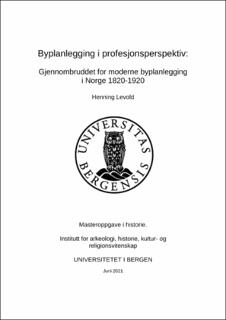Byplanlegging i profesjonsperspektiv: Gjennombruddet for moderne byplanlegging i Norge 1820-1920
Master thesis
Permanent lenke
https://hdl.handle.net/11250/2760972Utgivelsesdato
2021-06-02Metadata
Vis full innførselSamlinger
- Master theses [240]
Sammendrag
The Norwegian research literature vary in its dating of the emergence of “modern urban planning” in Norway. Some authors argue a breakthrough for “modern planning” can be traced as far back as approximately 1880, whereas others date it as late as 1920. The research literature is also dominated by architects, both as historians and as the leading “planning profession” in the historical presentations. This thesis aims to analyze the emergence of “modern urban planning” in Norway in the period 1820-1920. When did “modern urban planning” emerge in Norway, and which professions where the most prominent in the change? Analyzing the history of urban planning through other perspectives than the architects’, yields different answers to these questions than the research literature has previously provided. Apart from the architects, three other professions will be examined, as well as being used to examine the development of urban planning: the medical profession, the engineers, and the cultural heritage conservation “profession”. To answer these questions, this thesis utilizes three levels of analysis: the legal system, the public sphere, and the municipal administration. On the legal level, the laws governing urban planning will be analyzed, focusing mainly on Kristiana’s (Oslo) building regulations of 1827, as well as the national building regulations of 1845 and 1896. On the level of the public sphere, the professions understanding of urban planning will be studied by using the professions journals. The municipal administration-level will be analyzed by comparing six different regulation plans in Bergen and Kristiania. I argue substantial changes are seen on all three levels, and that the breakthrough of “modern urban planning” may be understood to have been a process spanning from 1876 to approximately 1910. Also, contrary to much of the existing research literature, I argue that both the medical professionals, as well as the engineers, were just as important “planning professions” as the architects in the emergence of “modern urban planning.” The Norwegian research literature vary in its dating of the emergence of “modern urban planning” in Norway. Some authors argue a breakthrough for “modern planning” can be traced as far back as approximately 1880, whereas others date it as late as 1920. The research literature is also dominated by architects, both as historians and as the leading “planning profession” in the historical presentations. This thesis aims to analyze the emergence of “modern urban planning” in Norway in the period 1820-1920. When did “modern urban planning” emerge in Norway, and which professions where the most prominent in the change? Analyzing the history of urban planning through other perspectives than the architects’, yields different answers to these questions than the research literature has previously provided. Apart from the architects, three other professions will be examined, as well as being used to examine the development of urban planning: the medical profession, the engineers, and the cultural heritage conservation “profession”. To answer these questions, this thesis utilizes three levels of analysis: the legal system, the public sphere, and the municipal administration. On the legal level, the laws governing urban planning will be analyzed, focusing mainly on Kristiana’s (Oslo) building regulations of 1827, as well as the national building regulations of 1845 and 1896. On the level of the public sphere, the professions understanding of urban planning will be studied by using the professions journals. The municipal administration-level will be analyzed by comparing six different regulation plans in Bergen and Kristiania. I argue substantial changes are seen on all three levels, and that the breakthrough of “modern urban planning” may be understood to have been a process spanning from 1876 to approximately 1910. Also, contrary to much of the existing research literature, I argue that both the medical professionals, as well as the engineers, were just as important “planning professions” as the architects in the emergence of “modern urban planning.”
